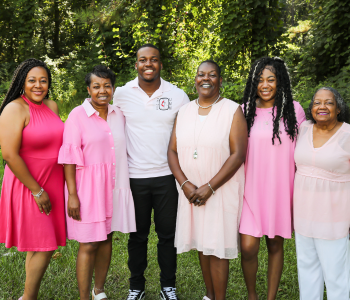She sees her primary care physician every year for a physical, too. And she always gets an annual screening mammogram at Tanner Breast Health in Carrollton.
“I try to keep up with everything,” said the single mom of two. “When it said women need to start doing their mammograms, I started getting it every year. I started at 40.”
So, her annual mammogram last winter was business as usual. Until she got a call that she needed to come in for a biopsy.
“I just panicked,” said Fortson. Her sister was again the first person she called, and she helped Fortson see the diagnosis in a new light with a little straight talk. “She said, ‘Why not you? Kids have cancer, a lot of people have cancer. Why not you? You’re no different than anyone else.’
“Once she told me that, my whole demeanor changed, and I just rolled with it.”
Fortson, who is active in her church community, started praying every night with her family. And thanks to her annual mammogram, the doctors found her breast cancer early, at stage 0.
DCIS is also described as an early form of breast cancer that is not invasive, and the malignant cells do not spread to lymph nodes or the blood stream.
Fortson met her Tanner breast surgeon, Raul Zunzunegui, MD, who explained that she would need a lumpectomy — surgical removal of the breast cancer — followed by radiation. She also wouldn’t require chemotherapy since her cancer was found at such an early stage.
.png)
Her surgery happened just before Christmas, but afterward, Dr. Zunzunegui — or “Dr. Z,” told Fortson that there was a close margin to the DCIS — a second surgery was advised.
Fortson again leaned on her community. It happened that a close friend, Sharon Thomas, revealed that she’d had DCIS as well as two surgeries. She encouraged Fortson to go back in for another surgery.
“At first, I didn’t want another surgery, but eventually decided I should. It could be cancer, or it could not be. But I didn’t want to look back on this moment five years from now and regret not having the surgery. I didn’t want to always be worrying that I should have had the surgery, so I went forward with the second surgery.”
The second procedure, which used the same incision as the first, found no additional cancer.
“I was just thrilled,” said Fortson. “It relieved me to know that it was nothing.”
After that, Fortson’s treatment was smooth sailing. During her lumpectomy, Dr. Z had placed a device called BioZorb into the cavity. The device is a spiral with six tiny titanium markers. Radiation oncologists can use the device to create a detailed map of where tissue was removed, helping them target radiation more precisely.
Fortson had 20 consecutive sessions of radiation — five days a week — to ensure any remaining malignant cells were destroyed. Sessions weren’t painful at all, she said.
She was also instructed to take and hold deep breaths during treatments – with breaks as needed — a technique that allows the lungs to fill with air so the heart moves away from the chest, helping protect it from radiation.
Throughout all her treatments, the nurses were right by her side, and she was very thankful.
“The nurses were great, and the ones that helped me through my radiation treatment made everything alright and made me feel at ease,” said Fortson.
It was May 16, 2023, when Fortson was able to ring the bell, signifying the completion of her radiation.
Her recovery was smooth. Fortson had timed her first surgery during vacation she’d already scheduled — “I just relaxed at home,” she said — and for the second, the recovery was even easier.
After radiation, the skin of her breast darkened and peeled, but she applied a prescribed cream and never had pain. “They told me exactly what would happen,” she said.
Following radiation, Fortson went on a hormone blocker to help prevent further breast cancer occurrences. But her best advice for everyone is still this: Get your annual mammogram.
“I’m just that type — I try to take care of my body. I’m 60, but people say I don’t look 60,” she said with a laugh. “I tell all my friends that it’s a good thing to get their mammogram.”
Screening mammograms are available through Tanner in Carrollton, Villa Rica and Bremen, and throughout the region on Tanner’s Mammography on the Move mobile mammography unit. Learn more at TannerBreastHealth.org or schedule your screening mammogram through Tanner’s MyChart app.